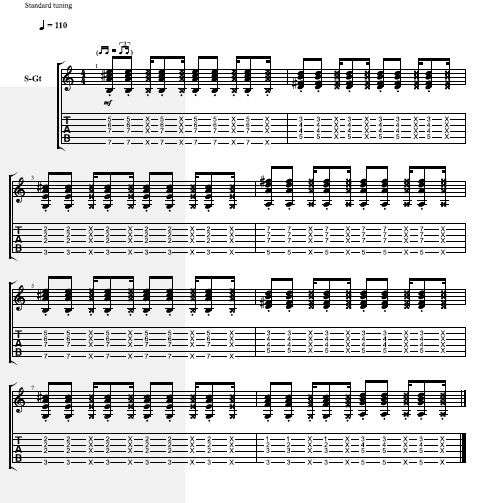So you want to get the funk out? Well you are in the right place. Guitar Control presents Berkley graduate and instructor Matias Rengel with a killer lesson Easy Killer Hybrid Guitar Chord Progressions. Be sure to get the tabs to go along with the step by step video instruction from Matias. Enjoy!
Hey, how’s it going this is Matias Rengel with Guitar Control, and today you’re going to learn Hybrid chords if you have any question please leave us a comment right below.
Hybrid Chords
So we’re going to start off by playing these hybrid chords at a slower speed. The basic idea of a hybrid chord is to play a chord on top of another note that doesn’t belong to the chord. For example let’s say that we have a C you know the normal C. We’re going to play C but instead of playing C as the root we’re going to play another note which doesn’t belong to the C chord. So let’s say we’re going to play on top of that we will be playing an F for example, let’s say that we’ll be playing C major and on top of that we’re going to play D, that’s the basic concept. So for this particular example that I’m showing you we start off playing a major chord and we play B, this is a very easy chord, we’re going to and we’re going to play and place our ring finger on the 7th fret of the 6th string and our pinky finger is going to go on the 7th fret of the 4th string. We’re not going to play the 5th string, so make sure that you’re muting it with your ring finger, and then we place our middle finger on the 6th fret of the 3rd string and the index finger on the 5th fret of the 2nd string. On the next quarter I’m going to play a Bm/D, for this chord you’re going to place your index, your ring, your pinky finger and you’re going to place it on the 5th fret of the 5th string and then you place your middle finger on the 4th fret of the 4th string and your ring finger on the 4th fret of the 3rd string and then you’re going to place the index finger on the 3rd fret of the 1st string. So for all the chords that I’m showing you try to play the notes that I’m telling you and no other notes. For example don’t play the six or the 1st string so you can go ahead and you can mute it either with your right hand. So clearly the 1st string you’re going to mute it with your index finger but for the 6th string you can put your right there. A lot of traditional guitar players are going to tell you, to not put you’re your thumb here, but honestly it’s whatever you want, so it’s more comfortable for you go ahead and do it.
The next chord we’re going to play will be an A/G. Very simple for this one you’re going to place your index finger on the 2nd fret of the 3rd and 2nd string like that place either your whatever is more comfortable for you, either your middle finger or ring finger on the 3rd fret of the 6th string and then after that we’re going to go into A ad major /A. So for this one there are many ways of playing it, I like to play it with my pinky finger and place it on the 7th fret of the 4th, 3rd and 2nd strings and then I place my index finger on the 5th fret of the 6th string and you could just play it with the pinky. Then we’re going to repeat that and change the ending here instead of going into the A into the D slash, we’re going to go into the same chord that we played at the beginning, this is basically a slash G and then we go into a G/A which is A/B, so if you’re asking what is this replacing most of the time, it’s replacing the chord that would otherwise be there from the root; so if I have an A/B it’s most likely replaced in some type of B. So for example I would say that in this progression will go something like this… and that’s it, I mean we’re adding other structure on top which changed the key and the feeling. If you want to experiment with this just grab a normal progression, let’s say you have like an E minor something else, let’s say you go into A and then we do it into an F and then to G; so for example you could start off and then you can change when you go here… this is totally different and then you going to G and you could go into a let’s say D major and that’s it that’s the basic concept of it, just practice like come up with your own progressions.
I hope you enjoyed this lesson that you’re able to incorporate hybrid chords into your daily playing I would love to know what you think about this lesson so please leave down a comment right below also remember to click on the link in the description or annotation to get the tab I would also love to know what you would like me to teach you next so please leave a comment right below telling me what you like my next lesson to be don’t forget to subscribe on our You Tube Channel and we’ll see you in our next video lessons, thanks for watching Easy Killer Hybrid Guitar Chord Progressions.
[ninja-popup ID=715]




